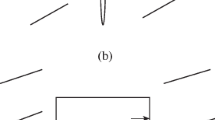Genetic classification is given for cracks with respect to origin in all stages of refractory production and use. Microcracks in refractories generate both due to external action and also due to internal thermal, mechanical, physical and chemical stresses of the first and second order. External and internal energy stress generators create more than twenty genetic types of micro- and macrocracks.









Similar content being viewed by others
Notes
Eloms are elastic composite refractory materials prepared from plastic organic mixes with a mineral filler.
References
I. G. Maryasev, L. M. Mikhailovskaya, L. D. Bocharov, et al., “Pores: their classification and role in actual refractory material structures,” Refract. Indust. Ceram., 52(3), 202 – 211 (2011).
V. A. Perepelitsyn and E. E. Grishenkov, “A classification of refractories: Properties,” Refract. Indust. Ceram., 45(5), 324 – 326 (2004).
K. K. Strelov, Refractory Structure and Properties [in Russian], Metallurgiya, Moscow (1982).
u. D. Kingery, Introduction to ceramics (P. P. Budknikov and D. N. Poluboyarinov, editors) [Russian translation], Stroiizdat, Moscow (1964).
V. V. Kolomeitsev, S. A. Suvorov, and E. F. Kolomeitseva, “Thermal stability of high-temperature materials. Part 1,” Refract. Indust. Ceram., 45(5), 327 – 332 (2004).
A. I. Natsenko, “Thermal shock resistance of brittle materials,” in: Theoretical and Technological Studies in the Field of Refractories [in Russian], Metallurgiya, Moscow (1971).
V. Dauknis, K. Kazakyavichus, G. Pranchyavishus, et al., Study of Heat Resistance of Refractory Ceramics [in Russian], Mintis Vilnyus (1971).
N. P. Yushkin, Mechanical Properties of Minerals [in Russian], Nauka, Leningrad (1971).
D. P. Grogor’ev, Mineral Ontogeny [in Russian], Izd. Lvov. State Univ., Lvov (1961).
V. A. Perepelitsyn, Bases of Technical Mineralogy and Petrography [in Russian], Nedra, Moscow (1987).
V. A. Perepelitsyn, “ General features of mineral substance high-temperature conversion,” Refract. Indust. Ceram., 53(2), 104 – 107 (2012).
G. Rouchka and H. Vitnau (editors), Refractory Materials. Structure, Properties, Testing: Handbook [Russian translation], Intermet Inzhiniring, Moscow (2010).
S. V. Sverguzova, E. N. Gonchareva, and Yu,. V, Burakova, “Study of biocorrosion of building materials by mathematical experimental planning,” Stroit Materialy, No. 1, 234 – 35 (2011).
O. N. Popov, P. T. Rybalkin,, V. A. Sokolov, and S. D. Ivanov, Production and Use of Fuzed Refractories [in Russian], Metallurgiya, Moscow (1985).
V. A. Rakhmanov, A. G. Marants, D. N. Poluboyarinov, and I. G. Duderov, “Reasons for cracking of melted and cast corundum objects,” Ogneupory, No. 7, 40 – 45 (1974).
L. D. Bocharov, V. M. Bibaev, and V. A. Perepelitsyn, “Genetic classification of magnesia object scrap,” Ogneupory, No. 4, 20 – 23 (1992).
L. D. Bocharov, I. G. Maryasev, A. G. Guzin, and V. G. Alfeeva, Classification of Product Nonconformity in OAO Kombinat Magnezit [in Russian], Izd. OAO Kombinat Magnezit, Chelyabinsk (2003).
Yu. E. Pivinskii and A. G. Romashin, Quartz Ceramic [in Russian], Metallurgiya, Moscow (1974).
A. S. Berzhnoi, Multicomponent Alkali Oxide Systems [in Russian], Naukova Dumka, Kiev (1988).
V. A. Perepelitsyn, L. D. Bocharov, and I. G. Maryasev, “Lining wear resistance in high-temperature tunnel furnaces,” Refract. Indust. Ceram., 50(1), 31 – 42 (2009).
V. A. Perepelitsyn, K. V. Simonov, and L. D. Bocharov, “Hightemperature ageing of basic refractories in slag-free media,” Conf. “Real structure of inorganic heat-resistant and high-temperature materials,” Proc. Pervoural’sk (1979).
Author information
Authors and Affiliations
Corresponding author
Additional information
Translated from Novye Ogneupory, No. 8, pp. 23 – 30, August, 2016.
Rights and permissions
About this article
Cite this article
Perepelitsyn, V.A., Kapustin, F.L., Zemlyanoi, K.G. et al. Crack Genesis in Refractories. Refract Ind Ceram 57, 394–400 (2016). https://doi.org/10.1007/s11148-016-9991-9
Received:
Published:
Issue Date:
DOI: https://doi.org/10.1007/s11148-016-9991-9




